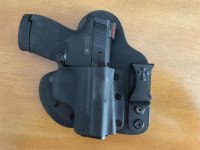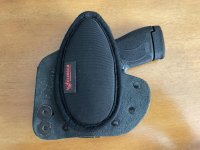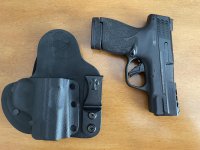Definitely the risks are not exactly the same.
Strong-side carry = 0% chance of shooting yourself in the junk
Appendix carry = non-zero percent chance of shooting yourself in the junk
With a ND or UD, no doubt the price of failure is probably going to be higher with appendix carry.
For many of us, in many circumstances, the choice isn't between appendix or strong-side carry, it's between appendix carry or not carry at all. Strong side carry simply does not work for all body types in all situations, especially with t-shirt thickness shirts, where absolute concealment is necessary.
Beyond social inconveniences, a CCW that's printing risks making you a target, much like open carry does, if you're in a public place and there's a bad guy with a concealed gun who's about to do something bad. It could easily be the guy behind you in line at the store who's eyeballing the handle poking through your shirt.
All of these are edge case scenarios with infinitesimal probabilities.
As someone who carries appendix every day, videos like the following one scare me, but by studying them we can learn to prevent these situations.
(warning: disturbing content)
Negligent Discharge by Glock - YouTube
In the video, we see him chamber a round, we see his holstering process with a Glock, we see him bend over, and we see the ND/UD. He's using a G-code kydex holster. This is a fit individual who's wearing a tucked in undershirt and another t-shirt over it.
I've studied that video and watched it more than 100 times, including dozens of times in slow motion. In slow motion, it's clear that something briefly inhibited his holstering and then once holstered he fidgeted with it as if something felt wrong.
Lessons:
To me, it appears some clothing worked it's way into the holster and got into the trigger guard. If that's the case, if the same scenario were repeated, a manual safety would have prevented that from happening, a feature that glock doesn't offer, but is present on many other guns.
Regardless if the manual safety is present, if something feels off while reholstering, you must stop and evaluate the situation instead of simply pushing through.
The inertial trigger dingus in a glock realistically rules out the potential of the holster itself pulling the trigger due to the kydex being sunk in around the trigger guard too much. (Just think of all the Sig P320/P365 owners with holsters that pinch the trigger)
With any gun, the possibility of a mechanical defect in the gun can't be ruled out entirely. In a striker fired gun, something as simple as a defective striker return spring, plunger spring, or sear spring could potentially set up the situation for a true uncommanded discharge to happen.
Here's an example of an uncommanded discharge (not graphic, no real injuries) where a post-update Sig P320 X5 fired uncommanded while holstered OWB, in the middle of a steel match with trained witnesses. The gun and holster were not light bearing. Sig Saur admitted that it was caused by a defective striker/firing pin return spring.
My Sig P320 fired on its own in the holster and tried to shoot me! (P320 X-Five) - YouTube
Lessons:
If he was carrying IWB, especially AIWB, he certainly would have had significant injuries, at minimum.
In the event of a defective spring situation, depending on the make/model of your gun, and depending which spring, potentially not even a manual safety would prevent an uncommanded discharge. If the striker slips off the sear for any reason, the gun will fire.
It's very important that anyone who carries a gun in any position is familiar with how the internals operate and that they inspect the function of those internals on a regular basis. For example, in my new Shield Plus I discovered that the safety plunger wouldn't reset on it's own. It's at S&W now for warranty service.
These defects can and do happen and no brand is immune and no carry position is absolutely safe.
The only way to carry a gun with a zero percent chance of shooting yourself from the holster is to carry without a round in the chamber. Just know that if you carry without one in the chamber, you're putting yourself at a significant tactical disadvantage if you need to draw the gun in self defense. You'll need to become an expert at quickly chambering a round as well as have a high level of situational awareness... but that still might not be quick enough and might not give you enough advanced notice.
As civilians, we carry guns to reduce the chances of death or great bodily harm due to a 2-legged or 4-legged threat. We mitigate risk of negligent discharges by training and we can mitigate the risk of defect by understanding and inspecting the mechanical functionality of what we carry.
We can help others do the same by sharing useful knowledge.
Telling people to only carry one way or another, as many commenters above did, helps no-one because other readers will just reject the info at the onset due to their existing bias, circumstances, or needs.



